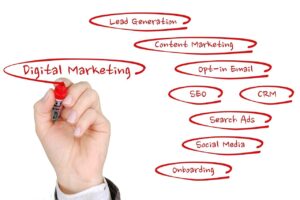Digital Marketing
Digital marketing is a multifaceted approach aimed at promoting products or services through various online channels. It encompasses a wide range of tactics and strategies to reach and engage with target audiences, drive traffic, generate leads, and ultimately, achieve business goals. In today’s digital age, where people spend a significant amount of time online, digital marketing has become increasingly essential for businesses of all sizes to stay competitive and reach their target market effectively. In other words, A variety of online platforms are used in digital marketing, which is a multidimensional strategy to advertise goods and services. To reach and interact with target audiences, increase traffic, produce leads, and eventually accomplish business objectives, it includes a broad range of techniques and strategies. In order for businesses of all sizes to remain competitive and successfully reach their target market in the modern digital age, where people spend a large amount of time online, digital marketing has become more and more important.

Key components and strategies of digital marketing
- Search Engine Optimization (SEO): SEO involves optimizing a website’s content and structure to rank higher in search engine results pages (SERPs) for relevant keywords. This organic traffic is crucial for increasing visibility and attracting potential customers.
- Content Marketing: Content marketing focuses on creating and distributing valuable, relevant, and consistent content to attract and retain a clearly defined audience. Content can include blog posts, articles, videos, infographics, eBooks, and more. It helps establish businesses as authorities in their industry and builds trust with their audience.
- Social Media Marketing: Social media platforms like Facebook, Instagram, Twitter, LinkedIn, and others are powerful channels for reaching and engaging with target audiences. Social media marketing involves creating and sharing content, interacting with followers, running ads, and analyzing engagement metrics to optimize performance.
- Email Marketing: Email marketing involves sending targeted messages to a list of subscribers to promote products, services, or content. It’s a highly effective way to nurture leads, maintain customer relationships, and drive conversions when done correctly.
- Pay-Per-Click Advertising (PPC): PPC advertising allows businesses to display ads on search engines and other platforms and pay a fee each time their ad is clicked. It’s a cost-effective way to drive traffic to websites and increase conversions, with platforms like Google Ads and Bing Ads offering sophisticated targeting options.
- Influencer Marketing: Influencer marketing involves collaborating with influencers, who have a dedicated following and influence over their audience, to promote products or services. It’s an effective way to reach niche audiences and leverage the trust that influencers have built with their followers.
- Affiliate Marketing: Affiliate marketing involves partnering with other businesses or individuals (affiliates) who promote your products or services in exchange for a commission for each sale or referral they generate. It’s a performance-based marketing strategy that can help businesses expand their reach and increase sales.
- Analytics and Data Analysis: Analyzing data and metrics is crucial for measuring the success of digital marketing campaigns and optimizing future efforts. Tools like Google Analytics provide valuable insights into website traffic, user behavior, conversion rates, and more, helping businesses make informed decisions.
In practice, digital marketing typically refers to online marketing campaigns that appear on a computer, phone, tablet, or other device. It can take many forms, including online video, display ads, search engine marketing, paid social ads and social media posts. The field of digital marketing is always changing as new platforms, technologies, and trends appear on a regular basis. Businesses must constantly adjust their strategies and stay abreast of the latest developments in order to succeed in the dynamic digital landscape.
Learn Digital marketing today at Buea institute of technology





One Response
I can not participate now in discussion – it is very occupied. I will return – I will necessarily express the opinion on this question.